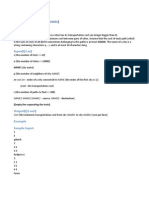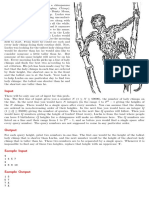p10048 PDF
p10048 PDF
Uploaded by
Jubaida SaimaCopyright:
Available Formats
p10048 PDF
p10048 PDF
Uploaded by
Jubaida SaimaOriginal Title
Copyright
Available Formats
Share this document
Did you find this document useful?
Is this content inappropriate?
Copyright:
Available Formats
p10048 PDF
p10048 PDF
Uploaded by
Jubaida SaimaCopyright:
Available Formats
Consider yourself lucky!
Consider yourself lucky to be still breathing and having fun participating in
this contest. But we apprehend that many of your descendants may not have this luxury. For, as you
know, we are the dwellers of one of the most polluted cities on earth. Pollution is everywhere, both in
the environment and in society and our lack of consciousness is simply aggravating the situation.
However, for the time being, we will consider only one type of pollution - the sound pollution. The
loudness or intensity level of sound is usually measured in decibels and sound having intensity level 130
decibels or higher is considered painful. The intensity level of normal conversation is 6065 decibels and
that of heavy traffic is 7080 decibels.
Consider the following city map where the edges refer to streets and the nodes refer to crossings.
The integer on each edge is the average intensity level of sound (in decibels) in the corresponding street.
To get from crossing A to crossing G you may follow the following path: A-C-F-G. In that case
you must be capable of tolerating sound intensity as high as 140 decibels. For the paths A-B-E-G,
A-B-D-G and A-C-F-D-G you must tolerate respectively 90, 120 and 80 decibels of sound intensity.
There are other paths, too. However, it is clear that A-C-F-D-G is the most comfortable path since
it does not demand you to tolerate more than 80 decibels.
In this problem, given a city map you are required to determine the minimum sound intensity level
you must be able to tolerate in order to get from a given crossing to another.
Input
The input may contain multiple test cases.
The first line of each test case contains three integers C(≤ 100), S(≤ 1000) and Q(≤ 10000) where
C indicates the number of crossings (crossings are numbered using distinct integers ranging from 1 to
C), S represents the number of streets and Q is the number of queries.
Each of the next S lines contains three integers: c1 , c2 and d indicating that the average sound
intensity level on the street connecting the crossings c1 and c2 (c1 ̸= c2 ) is d decibels.
Each of the next Q lines contains two integers c1 and c2 (c1 ̸= c2 ) asking for the minimum sound
intensity level you must be able to tolerate in order to get from crossing c1 to crossing c2 .
The input will terminate with three zeros form C, S and Q.
Output
For each test case in the input first output the test case number (starting from 1) as shown in the
sample output. Then for each query in the input print a line giving the minimum sound intensity level
(in decibels) you must be able to tolerate in order to get from the first to the second crossing in the
query. If there exists no path between them just print the line “no path”.
Print a blank line between two consecutive test cases.
Sample Input
7 9 3
1 2 50
1 3 60
2 4 120
2 5 90
3 6 50
4 6 80
4 7 70
5 7 40
6 7 140
1 7
2 6
6 2
7 6 3
1 2 50
1 3 60
2 4 120
3 6 50
4 6 80
5 7 40
7 5
1 7
2 4
0 0 0
Sample Output
Case #1
80
60
60
Case #2
40
no path
80
You might also like
- JBL Audio Engineering for Sound ReinforcementFrom EverandJBL Audio Engineering for Sound ReinforcementRating: 5 out of 5 stars5/5 (2)
- User Manual: HGM6100U Series Automatic Control ControllersDocument39 pagesUser Manual: HGM6100U Series Automatic Control ControllersMohamed R KhamissNo ratings yet
- The Singularity Is NearDocument4 pagesThe Singularity Is NearJohn Stanton100% (3)
- Greetings From Globussoft: All The Best For Your Test GlobussoftDocument8 pagesGreetings From Globussoft: All The Best For Your Test GlobussoftVishalNo ratings yet
- Jungle Run: (Input)Document7 pagesJungle Run: (Input)Santosh Kumar DesaiNo ratings yet
- Numerical Modelling of Stone Columns in Soft Clay Under An EmbankmentDocument7 pagesNumerical Modelling of Stone Columns in Soft Clay Under An EmbankmentebalicNo ratings yet
- PI Programming Questions VIIDocument11 pagesPI Programming Questions VIIDushyant GoyalNo ratings yet
- NWERC 2010: The 2010 ACM Northwestern Europe Programming ContestDocument22 pagesNWERC 2010: The 2010 ACM Northwestern Europe Programming ContestThượng Khanh TrầnNo ratings yet
- The 2009 ACM North Western European Regional Contest Friedrich-Alexander-University, Nuremberg, Germany November 8, 2009Document22 pagesThe 2009 ACM North Western European Regional Contest Friedrich-Alexander-University, Nuremberg, Germany November 8, 2009Qharl0sNo ratings yet
- 201320icpc14 Acm Icpc Central European Regional Contest Cerc 13 enDocument19 pages201320icpc14 Acm Icpc Central European Regional Contest Cerc 13 enRishabh JainNo ratings yet
- Problem SetDocument17 pagesProblem SetdarkdieuguerreNo ratings yet
- C/C++ Programming QuestionDocument8 pagesC/C++ Programming QuestionHimanshu JainNo ratings yet
- Problemset Naq 2016Document24 pagesProblemset Naq 2016Grimely SechehNo ratings yet
- Problems UlmDocument11 pagesProblems UlmJensen Ryan LimNo ratings yet
- NCPC 2014 October 4, 2014Document24 pagesNCPC 2014 October 4, 2014lequanghung98No ratings yet
- Acpc 2013Document19 pagesAcpc 2013Moncef MhasniNo ratings yet
- Contest1 TasksDocument9 pagesContest1 TasksViet DinhvanNo ratings yet
- Over Nite MainsDocument9 pagesOver Nite Mainspankajthakur950No ratings yet
- Greetings From Globussoft: Search Engine Like Google, Yahoo, BingDocument7 pagesGreetings From Globussoft: Search Engine Like Google, Yahoo, BingPriyanka SNo ratings yet
- Chapter 1: Introduction To Communication Systems Multiple ChoiceDocument3 pagesChapter 1: Introduction To Communication Systems Multiple ChoiceAylie PilobelloNo ratings yet
- 1 - Intro To Computing AlgorithmsDocument13 pages1 - Intro To Computing AlgorithmsNouran SherifNo ratings yet
- ACM ICPC Problems 2008 PDFDocument23 pagesACM ICPC Problems 2008 PDFhernantionNo ratings yet
- Matlogix Question 2012Document12 pagesMatlogix Question 2012Aman04509No ratings yet
- Zonal Computing Olympiad 2019: Singing Tournament (SINGTOUR)Document4 pagesZonal Computing Olympiad 2019: Singing Tournament (SINGTOUR)Yamini mulumudi100% (1)
- ACM International Collegiate Programming Contest 2008: South American Regional ContestsDocument23 pagesACM International Collegiate Programming Contest 2008: South American Regional ContestsPhạm Hữu Thạnh ĐạtNo ratings yet
- ACM ICPC Problem Set 2011Document14 pagesACM ICPC Problem Set 2011wazazzu3349No ratings yet
- A - Special Numbers: Problem Code: BONUMBERDocument9 pagesA - Special Numbers: Problem Code: BONUMBERale_tjaNo ratings yet
- Zohocorp QN Set 1Document7 pagesZohocorp QN Set 1VarozNo ratings yet
- Codeforces Trainings S02e04Document10 pagesCodeforces Trainings S02e04AlhepSoftAlhepNo ratings yet
- Zco 2011Document6 pagesZco 2011Jennifer AnthonyNo ratings yet
- International Tournament in Informatics 24 November, 2012, Shumen, Bulgaria Junior Group Task B1. BalanceDocument3 pagesInternational Tournament in Informatics 24 November, 2012, Shumen, Bulgaria Junior Group Task B1. BalanceAndreea ZahariaNo ratings yet
- Problem 1 Name: Fair Liar: Input SpecificationsDocument7 pagesProblem 1 Name: Fair Liar: Input SpecificationsNishant YadavNo ratings yet
- 2000 CCC Stage 1 ContestDocument10 pages2000 CCC Stage 1 ContestHcone GnechNo ratings yet
- Chapter 5Document21 pagesChapter 5Carlos Eduardo S. MartinsNo ratings yet
- Assignment 1 - VIT BHOPALDocument7 pagesAssignment 1 - VIT BHOPALShekhar SharmaNo ratings yet
- Importance of Technical Research in Long-Distance Sound PropagationDocument31 pagesImportance of Technical Research in Long-Distance Sound PropagationatpeplowNo ratings yet
- Problem A: Sigma FunctionDocument14 pagesProblem A: Sigma FunctionssNo ratings yet
- Sample Midterm Physics 130Document9 pagesSample Midterm Physics 130Peter LiNo ratings yet
- 1990 ACM-ICPC World Finals ProblemsDocument14 pages1990 ACM-ICPC World Finals ProblemsMohd ShahrilNo ratings yet
- 2009 Koi PDFDocument13 pages2009 Koi PDFPhạm Hữu Thạnh ĐạtNo ratings yet
- 06-11-2021 - SR Iit Co Sc-n120 - Jee Main Model - ptm-1 - QP FinalDocument14 pages06-11-2021 - SR Iit Co Sc-n120 - Jee Main Model - ptm-1 - QP FinalDeeip DNo ratings yet
- DSA InterviewDocument10 pagesDSA Interviewmamta palNo ratings yet
- Problem Set: The 34 ACM International Collegiate Programming Contest Asia Regional Contest - HefeiDocument23 pagesProblem Set: The 34 ACM International Collegiate Programming Contest Asia Regional Contest - HefeiPhạm Hữu Thạnh ĐạtNo ratings yet
- Chapter 4 Color in Image and VideoDocument11 pagesChapter 4 Color in Image and VideoZeyad GomaaNo ratings yet
- Laboratory 4 Data Transmission Through A Noise-Limited Communication ChannelDocument6 pagesLaboratory 4 Data Transmission Through A Noise-Limited Communication ChannelElisbeth MurugasNo ratings yet
- Gatecounsellor: Aptitude Questions - 1Document3 pagesGatecounsellor: Aptitude Questions - 1parimalaseenivasanNo ratings yet
- Problem Set 4: MAS160: Signals, Systems & Information For Media TechnologyDocument4 pagesProblem Set 4: MAS160: Signals, Systems & Information For Media TechnologyFatmir KelmendiNo ratings yet
- BdOI National 2013Document11 pagesBdOI National 2013Muntakim SadikNo ratings yet
- Blake Multiple Problems CompleteDocument169 pagesBlake Multiple Problems CompleteJorge andresNo ratings yet
- ProblemsDocument20 pagesProblemsTanmoy PatraNo ratings yet
- Mu Spring 2012Document26 pagesMu Spring 2012jesantiagoqNo ratings yet
- Préparation Au Concours ACM - TP 1: Christoph Dürr Jill-Jênn Vie September 19, 2014Document9 pagesPréparation Au Concours ACM - TP 1: Christoph Dürr Jill-Jênn Vie September 19, 2014ahlam1707No ratings yet
- Bracu Joyjatra 50 Techfest Inter UniversityDocument14 pagesBracu Joyjatra 50 Techfest Inter UniversityHeuheuNo ratings yet
- Problem A. Arrays: InputDocument15 pagesProblem A. Arrays: InputHao DoNo ratings yet
- Extra Tut 5 SolsDocument4 pagesExtra Tut 5 SolsNOMPUMELELO MTHETHWANo ratings yet
- V - Maratón de Programación: Roads in The North (10308)Document9 pagesV - Maratón de Programación: Roads in The North (10308)Juan Alberto AcostaNo ratings yet
- Problem Set This Problem Set Contains 7 Questions (A G) Input: Standard Input Output: StandardDocument10 pagesProblem Set This Problem Set Contains 7 Questions (A G) Input: Standard Input Output: StandardAqim FaridNo ratings yet
- Icpc2012 ProblemsDocument24 pagesIcpc2012 ProblemsGastón Bengolea MonzónNo ratings yet
- ACM-ICPC Malaysia Al-Khawarizmi Programming Contest 2009Document16 pagesACM-ICPC Malaysia Al-Khawarizmi Programming Contest 2009Caey ZenNo ratings yet
- Easy(er) Electrical Principles for Extra Class Ham License (2012-2016)From EverandEasy(er) Electrical Principles for Extra Class Ham License (2012-2016)No ratings yet
- Quick Crochet for Kitchen and Home: 14 Patterns for Dishcloths, Baskets, Totes, & MoreFrom EverandQuick Crochet for Kitchen and Home: 14 Patterns for Dishcloths, Baskets, Totes, & MoreNo ratings yet
- Assignment: Course Code: CSE-4203 Course Title: Neural Networks and Fuzzy SystemDocument1 pageAssignment: Course Code: CSE-4203 Course Title: Neural Networks and Fuzzy SystemJubaida SaimaNo ratings yet
- Problem SpaceDocument25 pagesProblem SpaceJubaida Saima0% (1)
- InputDocument1 pageInputJubaida SaimaNo ratings yet
- Input: N Is A Number Less Than 1,000,000,000 and The Given Date Is Any Date Before The Year 3000Document1 pageInput: N Is A Number Less Than 1,000,000,000 and The Given Date Is Any Date Before The Year 3000Jubaida SaimaNo ratings yet
- Input: X X X X N X X X XDocument1 pageInput: X X X X N X X X XJubaida SaimaNo ratings yet
- Direct Hashing and Pruning (Park-Chen-Yu) Direct Hashing and PruningDocument3 pagesDirect Hashing and Pruning (Park-Chen-Yu) Direct Hashing and PruningJubaida SaimaNo ratings yet
- Input: L) Representing The Places Where The CutsDocument1 pageInput: L) Representing The Places Where The CutsJubaida SaimaNo ratings yet
- Ai SearchDocument11 pagesAi SearchJubaida SaimaNo ratings yet
- DSP TheoryDocument5 pagesDSP TheoryJubaida SaimaNo ratings yet
- Project DevsecopsDocument24 pagesProject DevsecopsdbabupdtrNo ratings yet
- ENARSI Chapter 22 STDocument34 pagesENARSI Chapter 22 STMaurice SarrNo ratings yet
- Battlespire Athenaeum TextDocument202 pagesBattlespire Athenaeum TextZlobnyj SosatelNo ratings yet
- Utility CDDocument9 pagesUtility CDTan Beng100% (1)
- Www-GeeksforgeeksDocument11 pagesWww-GeeksforgeeksStock by RKNo ratings yet
- How To Manually Restore A WordPress Site From A WordPress BackupDocument15 pagesHow To Manually Restore A WordPress Site From A WordPress BackupMmdNo ratings yet
- Prometric India Contact NumberDocument4 pagesPrometric India Contact NumberWANNA WOHNo ratings yet
- FusionHome Catalogue AUDocument28 pagesFusionHome Catalogue AUCameron HaugNo ratings yet
- Jayant Kumar ChoudharyDocument3 pagesJayant Kumar ChoudharyAnonymous sjBEEONo ratings yet
- DW670Document1 pageDW670Joel ArvendoNo ratings yet
- DictionaryDocument3 pagesDictionaryaishwarriyaNo ratings yet
- DSO Activation FailedDocument12 pagesDSO Activation Failedkalicharan13No ratings yet
- Login and Registration Process in WPF ApplicationDocument10 pagesLogin and Registration Process in WPF ApplicationAbhiNo ratings yet
- AI F20 Lecture-5-6Document23 pagesAI F20 Lecture-5-6Ishtiaq bhatti Ishtiaq bhattiNo ratings yet
- Edulito Practice Exams 1 AQA 8525-1 Computational Thinking & ProgrammingDocument24 pagesEdulito Practice Exams 1 AQA 8525-1 Computational Thinking & Programmingh19sy1No ratings yet
- End User Applications (Asm452) Tutorial Part C: Microsoft Excel (40 Marks)Document3 pagesEnd User Applications (Asm452) Tutorial Part C: Microsoft Excel (40 Marks)ummi hanisahNo ratings yet
- Functions and Triggers PDFDocument23 pagesFunctions and Triggers PDFXie PeiyiNo ratings yet
- 3 Hours / 70 Marks: Seat NoDocument4 pages3 Hours / 70 Marks: Seat NoKrishnaNo ratings yet
- Amphenol Audio CatalogueDocument148 pagesAmphenol Audio CatalogueWalter LemosNo ratings yet
- 116 MS-Excel - Assignment 2022Document10 pages116 MS-Excel - Assignment 2022Akshay GarudNo ratings yet
- Mini Documentary ImpromptuDocument2 pagesMini Documentary ImpromptumunirahNo ratings yet
- Ldap HowtoDocument39 pagesLdap Howtomana1345No ratings yet
- VLSI Design Lab ManualDocument159 pagesVLSI Design Lab ManualARUN PRAKASH BNo ratings yet
- Applying TIA 942 in DatacenterDocument5 pagesApplying TIA 942 in DatacentereriquewNo ratings yet
- The Schemes and Performances of Dynamic Branch Predictors: Chih-Cheng ChengDocument18 pagesThe Schemes and Performances of Dynamic Branch Predictors: Chih-Cheng ChengAhmed IbrahimNo ratings yet
- Manual 3DS Dragon Quest VIII enDocument61 pagesManual 3DS Dragon Quest VIII ensatriya DhinataNo ratings yet

































































































